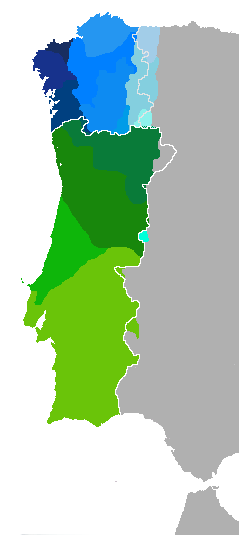Galician-Portuguese language
Galaico-Portuguese or Galician-Portuguese, also known as Old Galician or Medieval Portuguese, was the Romance language spoken during the Middle Ages throughout the northwestern fringe of the Iberian Peninsula, from the Cantabrian Sea to the Duero River. From the evolution of this language come the current Galician and Portuguese languages, which reintegrationism currently considers a single language, despite their diatopic differences. In Portugal, Galaico-Portuguese is also called Medieval Portuguese, as well as in Galicia, more properly, Old Galician.
History of Galician-Portuguese
The Portuguese king Don Dinis declared Portuguese the official language of the administration of the kingdom in 1290 (until then Latin was the official language).
Medieval Galician-Portuguese was most important in the Peninsula from the end of the XII century until the middle of the XIV. Around 1400 Galician-Portuguese was, for some authors, losing its unity as a result of the division of its land between two different states (the Kingdom of Portugal and the Kingdom of Galicia) and the fact of the imposition of Castilian (due to officialdom / obligatory nature of Castilian for official writings and other necessities) and colonialism within Galicia itself (with which the Galician version of the language began to be influenced by Castilian). Thus, some authors defend that it was separated into two different versions: the Galician and the Portuguese.
The idiomatic separation of the two linguistic varieties is currently discussed by the different philological schools or opinion groups regarding this topic. Currently there are diatopic differences between Galician and Portuguese. Portuguese, mainly the one spoken south of the Duero, adopted many Arabic words and from the XVI century from the former Portuguese colonies in South America, Africa, Asia and Oceania.
Characteristic spellings
- For the fonema / / (sided window) graphed today with ll (Gallego); "lh" (Portuguese).
- For the fonema / / (Nosepalatal) graphed at present with "ñ" (gallego); "nh" (portugués).
Linguistic description
Phonology
- Vocalism
- Unlike the current Galician, but not Portuguese, medieval vocalism presented as the most outstanding characteristic the existence of nasal vowels, product of the loss of a /n/ intervocálica: lanam ▪ lãa.
- In the face of the current Galician, many vocalic groups were bisilábic, which in today's Galician constitute a syllable (a syllable) (ve-er for See).
- Consonantism
One of the most important features of Galician-Portuguese medieval phonology is the existence of three pairs of sibilants that have evolved differently in Portuguese and Galician:
- The pair of predorsodental Africans /dz/ and /ts/ (sound and deaf) converged in Galician in the sorda interdental fricative, common to Spanish, /θ/; in Portuguese the opposition was preserved in relation to the sonority /z/ and /s/, now predorsodental fricatives.
- The pair of alveolar fricatives /z/ and /s/ confluyen in the current Galician in the sorda /s/ consonant but the difference is maintained at the point of articulation with the interdental /θ/: step /passo/ vs. peace /paθo/, while in Portuguese this pair conflues with the previous one, the two pairs are reduced to one whose two elements are equal
- The last pair, the one of the post-veolar or pre-palatal fricatives, evolved in Galician following the trend of the previous and the Spanish, that is, eliminating the opposition in terms of the sonority / ADD/ and/A/ confluyen in / ARR/ CASEUS ▪ I demand /kej girao/ queixo /kej arc/; in Portuguese the pair / arc/ and / arc/: /k.j tripu/ and /kʃj arc/ but the africada /t arc/ of the galaico-portugués that still stays in Galician, has desafricated in most of the luso territory, as /dz/ and /ts/ and conflue with the socativa lice
In other words, both Portuguese and Galician tended to simplify the complex system of medieval sibilants in different ways. The Portuguese opted for the elimination of the differentiation in terms of the point of articulation such as the Spanish American and Andalusian accents, while the Galician opted for the elimination of the opposition in sonority.
Medieval lyric in Galician-Portuguese
During the Middle Ages, Galician-Portuguese was the vehicle of an important literary tradition, Galician-Portuguese lyric, which has come down to us in three songbooks:
- Ajuda Songbook
- Songbook of the Vatican Library
- Cancionero Colocci-Brancuti
- Cancionero de Santa María del Puerto
- Cancioneiro dun Grande de Espanha
- Pergaminho Vindel
- Pergaminho Sharrer
- You 5 lais of Bretanha
- Tenzón entre Afonso Sánchez e Vasco Martíns de Resende
Some outstanding poets were: Bernardo de Bonaval, Airas Nunes, Pero da Ponte, Pero Amigo and Martín Codax or the Portuguese king Don Dinis "troubadour king". The literary use of Galician-Portuguese was not limited to the west of the Peninsula, but was also widely cultivated in the kingdoms of Castilla and León. King Alfonso X the Wise, of Castile, composed his Cantigas de Santa María and several cantigas de Escarnio e Maldizer in Galician-Portuguese.
Contenido relacionado
Battle of britain
39
Annex: Annual table of the 3rd century
